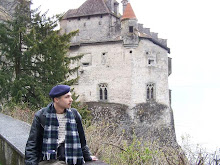So when said small group of people asked me if I'd be interested in teaching a class on brick stitch, with which I've become rather familiar, I of course said that I would. So, I began coming up with some class materials, including a handout, a large-format visual aid, and naturally I brought along a lot of my own work so my 'students' so see some examples up close and personal.
The other thing I did, which—and I hate to seem immodest here—I thought was a rather clever idea, was hand out a student feedback form in the last few minutes, in which the participants good give me comments and criticisms about my class, my teaching method, whatever. But I liked having these little comments to work off of to improve the class whenever I teach it again. And also during the course of teaching, I noticed little things myself, for example an erroneous comment in my handout in which I misinterpreted an example of gobelin stitch for brick stitch.
 Although I'm sure many of my readers already have at least a working knowledge of brick stitch, but once I have an updated version of my handout, perhaps I will post it up here (I say "perhaps" because I'm concerned about certain museums' images I've used without permission). Things I'm improving bit by bit include: editing and expanding on some of the historical info, adding a list of relevant books and articles besides the ones I directly cite, and adding some more images of extant pieces. I've already added tutorial graphics (as per one student's request), and added a few more embroidery patterns that they can work from.
Although I'm sure many of my readers already have at least a working knowledge of brick stitch, but once I have an updated version of my handout, perhaps I will post it up here (I say "perhaps" because I'm concerned about certain museums' images I've used without permission). Things I'm improving bit by bit include: editing and expanding on some of the historical info, adding a list of relevant books and articles besides the ones I directly cite, and adding some more images of extant pieces. I've already added tutorial graphics (as per one student's request), and added a few more embroidery patterns that they can work from.Some other comments (which, happily, were all positive) included the wish for more time (and I agree, 1 hour was decent enough for the presentation aspect, but not really for the hands-on portion), and I did overhear one person telling another about how refreshing? it was to attend a needlework class taught by a man. I smiled at that :-)



